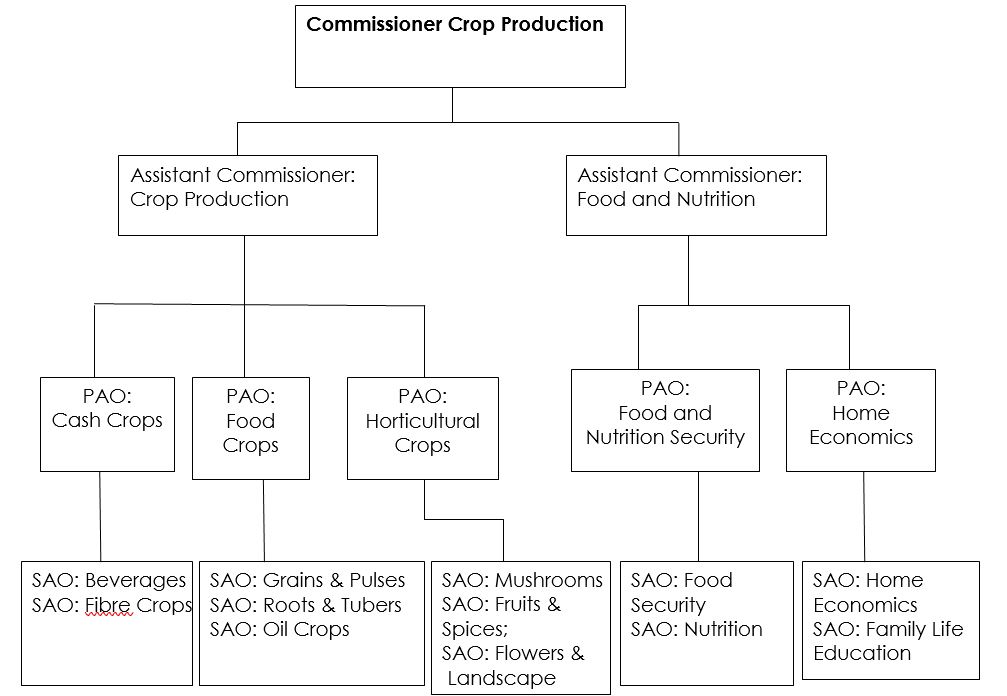Department of Crop Production
Mandate
To support, promote and guide:-
- Sustainable Market Oriented Production
- Value Addition,
- Quality Assurance and capacity building of TOTs
- Food and Nutrition Security
Objective
Support sustainable inspection and crop production
Structure of the department
The department is composed of two divisions, namely:
- Crop Production Division
- Food and Nutrition Security division
On top is the commissioner, followed by Assistant Commissioner Crop production and Assitant Commissioner Food and Nutrition.
Below is the structure for the department. The highlighted positions are vacant.

key functions and outputs
Key Functions
- Formulate and review policies, standards and plans on crop production, post-harvest handling, primary processing, marketing and food and nutrition security.
- Provide quality assurance on good agricultural practices and advisory services on crop production, primary processing, marketing and food and nutrition.
- Build capacity of service providers on crop production, primary processing, marketing, food and nutrition.
- Support the provision of improved seed/planting materials and suitable use of natural resources.
- Conduct food and nutrition security surveillance in the country.
- Develop and guide implementation of programmes for integration of the youth in crop production, primary processing and marketing.
Key Outputs/ Activities
- Draft, review, update and finalize crop production;
- Strategies
- Guidelines
- Standards
- Promotion of production and Productivity of priority Commodities through;
- Capacity building of TOTs on Good Agricultural Practices (GAP) for priority crop commodities along the value chain and climate change adaption.
- Promotion and maintenance of Farmer Field Schools
- Supervision, monitoring and technical backstopping undertaken for all district local governments
- Collection of crop data.
- Development of crop manuals
- Collaboration and participate in regional and international technical conferences, exhibits, study tours and workshops
- Food and nutrition security ensured through;
- Capacity of TOTs food and nutrition security.
- Carrying out Food and Nutrition Security surveillance in Uganda and developing strategies to improve the situation.
- Integrating Food and Nutrition packages in schools and school gardening developed/ reviewed in collaboration with other stakeholders.
- Increased value addition of priority commodities though;
- Initiation of Public Private Partnerships (PPP’s) along the commodity value chain.
- Establishment and maintenance of technology incubation centers
Projects
Uganda Multi-Sectoral Food Security and Nutrition Project
The overall Objective is to increase production and consumption of micro-nutrient rich foods and utilization community based nutrition services in smallholder households in project areas.
Agriculture Cluster Development Project
The overall objective is to raise on-farm productivity, production and marketable volumes of selected agricultural commodities in specified geographical clusters. The project shall support farmers with subsidies through the E-voucher system.
Potato Commercialization Project
The objectives of the project include:
- To support commercial production of Potato tubers in Uganda
- To improve marketing of Potato value chain for the Ugandan as well as for the East-African and COMESA market through linking producers to buyers.
- To improve access to agricultural information and financial services among the smallholder potato farmers.
- To support sustainable production of Potato Tubers in Uganda.
- The project is in six districts of Kisoro, Kabale, Kanungu, Kyegegwa, Kibale and Mityana.
Rice Development Project (PRiDE)
The project Objectives include:
- To increase rice production in Uganda by at least 20,000 MT
- To build capacity of 120 rice millers to enable them upgrade their rice mills to turn out milled rice top at least grade 3 of UNBS standard.
Northern Uganda Farmers Livelihoods Improvement Project
The overall objective is to establish an effective market oriented agricultural production approach to improve farmers’ livelihood in Northern Uganda. Project is in phases, phase one is in three districts of Gulu, Kitgum and Paderand later four other districts will be brought on board:-the districts of Nwoya, Lammo and Amuru.
Banana Livelihoods Diversification Project
The project aims at reducing Vulnerability of Banana Producing Communities to Climate Change through Banana Value Added Activities - Enhancing Food Security and Employment Generation.This project is in the eight districts of western Uganda:-Bushenyi, Sheema, Mitooma, Isingiro, Mbarara, Buhweju,Ntungamu and Rubirizi.
Support for Cocoa Tea Seedlings
The project objectives include:
- To increase Tea and Cocoa production in the traditional and new growing areas.
- To increase household incomes of tea and cocoa farmers.
- To increase foreign exchange earnings of Uganda, through exports of tea and cocoa.
Head of Department: www.agriculture.go.ug/ccp-alex-lwakuba/
